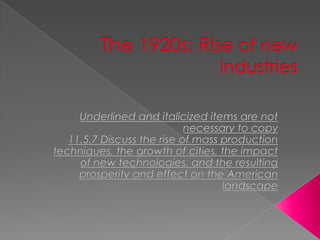Us 1920 new industries
- 1. The 1920s: Rise of new industriesUnderlined and italicized items are not necessary to copy11.5.7 Discuss the rise of mass production techniques, the growth of cities, the impact of new technologies, and the resulting prosperity and effect on the American landscape
- 2. The Assembly LineMass production: the large scale product manufacturing, rapidly increases in the 1920sIncreased efficiency makes 8 hour 5 day work week possible (previously 12 hour six day work week)Most notable in automobile industry with Henry FordUsed assembly line: a set up that divides operations into simple tasks that unskilled works can complete
- 3. Model T and workersThe Model T was the first car owned by millions of Americans- creates commuter culture (traveling far for work)1908 sold for $850, 1924 sold for $295many bought by Ford’s workers who were paid enough to own cars, helps promote the open shop: where unions are optionalWelfare capitalism emerges: workers can buy stock, profit share, and get benefits (medical and pensions)Why was Ford able to drop the cost of this car so drastically in 16 years?
- 4. Airline and RadioAirline industry spurred by WW1 need for planesLeads to air mail and commercial flights for the rich/well off in the 1920sCharles Lindbergh (1927) makes first intercontinental flight, becomes national heroNBC (National Broadcasting Company and CBS (Colombia Broadcasting System) provide radio programmingBy 1929 10 million radio sets are in use
- 5. Consumer Goods and CreditMany new goods appears in the 1920s such as: electric irons, vacuum cleaners, washing machines, refrigerators, gas stoves, mouthwash, deodorant, electric razors, and frozen foodsBefore 1920s: Debt=shameDuring 1920s: Debt=StuffMany goods bought on installment plan: debtor society helps lead to Great Depression
- 6. Mass AdvertisingMass ads created to convince people they needed something they had never heard of:Focused on fears and anxieties: such as weight or personal odorRadio and newspaper utilized to spread ads (mass media)
